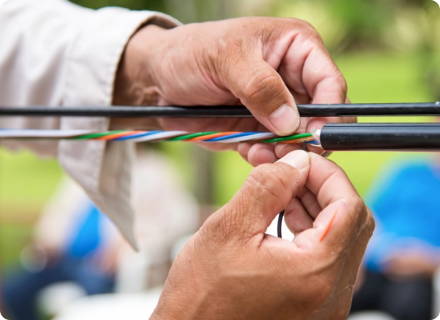Wire and cable form the backbone of modern electrical and communication systems, serving as essential components that power our homes, businesses, and critical infrastructure. Understanding the distinctions between wire and cable, their various types, and appropriate applications is crucial for ensuring safety, reliability, and optimal performance across multiple industries.
Wire and cable might appear similar at first glance, but they serve distinct purposes with different structural characteristics. A wire typically refers to a single conductor or multiple conductors with basic insulation, designed for simple electrical connections. In contrast, a cable consists of multiple wires or conductors bundled together with additional protective layers, shielding, and insulation to handle more complex transmission requirements. This fundamental difference determines their respective applications across various sectors.
Understanding the structural differences is key to proper selection. Wires generally feature a simple construction with one or more conductors (often copper or aluminum) surrounded by a single layer of insulation. They're commonly used in low-voltage applications, such as internal electronics wiring, automotive circuits, and basic household electrical connections. Cables, however, incorporate multiple conductors, often with specialized arrangements like twisted pairs, coaxial designs, or fiber optic strands, all protected by multiple layers including fillers, shielding, and robust outer jackets. This complex structure enables cables to handle higher voltages, greater current loads, and provide superior protection against environmental factors and electromagnetic interference.
The electrical industry categorizes wire and cable products into five primary classifications: power cables, bare wires, electrical equipment wires and cables, communication cables and optical fibers, and winding wires. Each category serves specific functions and operates under different technical requirements. Power cables, for instance, range from low-voltage residential wiring to ultra-high-voltage transmission lines capable of carrying electricity across continents. Communication cables have evolved dramatically to support our digital age, with fiber optic cables now transmitting data at near-light speeds across global networks.
One of the most significant applications of wire and cable technology is in power transmission and distribution. From the massive overhead transmission lines that carry electricity across vast distances to the intricate wiring within residential buildings, these components form the critical infrastructure that powers modern civilization. High-voltage power cables must withstand extreme electrical stresses while maintaining insulation integrity, often requiring specialized materials like cross-linked polyethylene (XLPE) or ethylene tetrafluoroethylene (ETFE) for superior thermal and electrical properties.
Communication systems represent another major application area where wire and cable technology has revolutionized connectivity. Modern data centers rely on advanced structured cabling systems using Category 6A, 7, or 8 twisted-pair cables for high-speed Ethernet connections, while fiber optic cables enable terabit-per-second data transmission across continents. These communication cables incorporate sophisticated shielding and precise conductor geometries to minimize signal degradation and electromagnetic interference, ensuring reliable data transmission even in electrically noisy environments.
The automotive industry has become increasingly dependent on specialized wire and cable solutions as vehicles incorporate more electronic systems. Modern automobiles contain miles of wiring harnesses that must withstand vibration, temperature extremes, and potential exposure to chemicals. With the rise of electric vehicles, high-voltage cable systems capable of handling 400-800 volts have become essential components, requiring advanced insulation materials and robust construction to ensure safety and reliability.
Industrial applications present some of the most challenging environments for wire and cable products. Factories, power plants, and manufacturing facilities require cables that can withstand mechanical stress, chemical exposure, extreme temperatures, and potentially explosive atmospheres. Specialized cable types such as tray cable, portable cord, and instrumentation cable have been developed specifically for these demanding applications, often incorporating features like oil resistance, flame retardancy, and enhanced mechanical protection.
Specialty wire and cable products address unique requirements across various sectors. These include high-temperature cables for aerospace applications, low-smoke zero-halogen (LSZH) cables for confined spaces like subways and aircraft, and medical-grade cables designed for patient safety and biocompatibility. Renewable energy installations, particularly solar and wind farms, utilize specialized photovoltaic (PV) wire and wind turbine cables engineered to withstand outdoor exposure and deliver reliable performance for decades.
Material science continues to drive innovation in wire and cable technology. Advanced polymer formulations provide improved insulation properties, while nanotechnology is being explored to enhance conductivity and reduce weight. The development of halogen-free flame retardant materials addresses environmental concerns while maintaining safety standards. Additionally, smart cable technologies incorporating sensors for temperature monitoring and fault detection are becoming increasingly common in critical infrastructure applications.
Proper testing and certification are essential for ensuring wire and cable products meet safety and performance standards. Organizations like UL Solutions provide comprehensive testing services that verify compliance with international standards, including safety, performance, quality, and reliability assessments. These certifications give manufacturers, installers, brand owners, retailers, regulatory bodies, and consumers confidence in product performance across various applications.
When selecting wire and cable products for specific applications, several critical factors must be considered: voltage rating, current carrying capacity, environmental conditions, installation method, and regulatory requirements. The wrong choice can lead to premature failure, safety hazards, or suboptimal performance. Consulting with wire and cable specialists and referencing industry standards helps ensure the right product selection for each unique application.
The future of wire and cable technology points toward increased integration with smart infrastructure systems, enhanced sustainability through recyclable materials, and continued performance improvements to support emerging technologies like 5G, IoT, and next-generation electric vehicles. As our world becomes increasingly connected and electrified, the importance of reliable, high-performance wire and cable solutions will only continue to grow.
For manufacturers and users alike, staying informed about the latest developments in wire and cable technology, understanding application-specific requirements, and partnering with trusted testing and certification organizations like UL Solutions ensures that these critical components continue to deliver safe, reliable performance across all sectors of the global economy.



